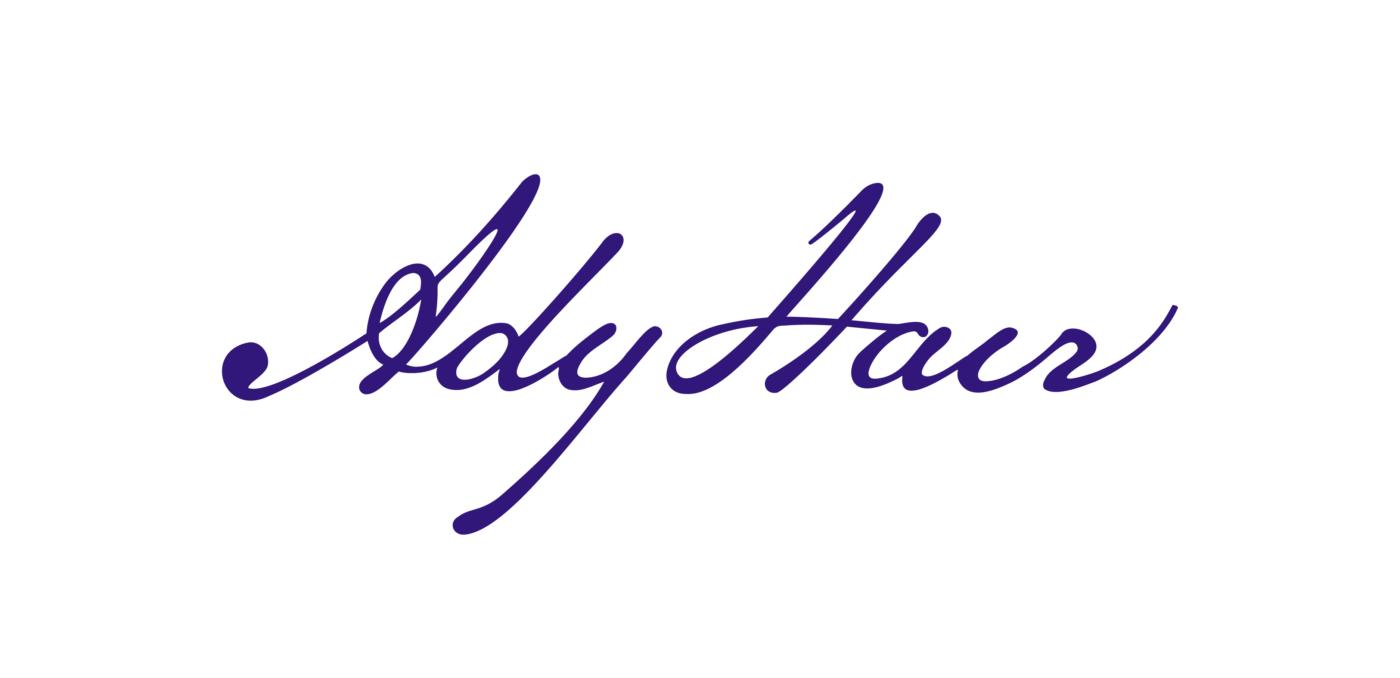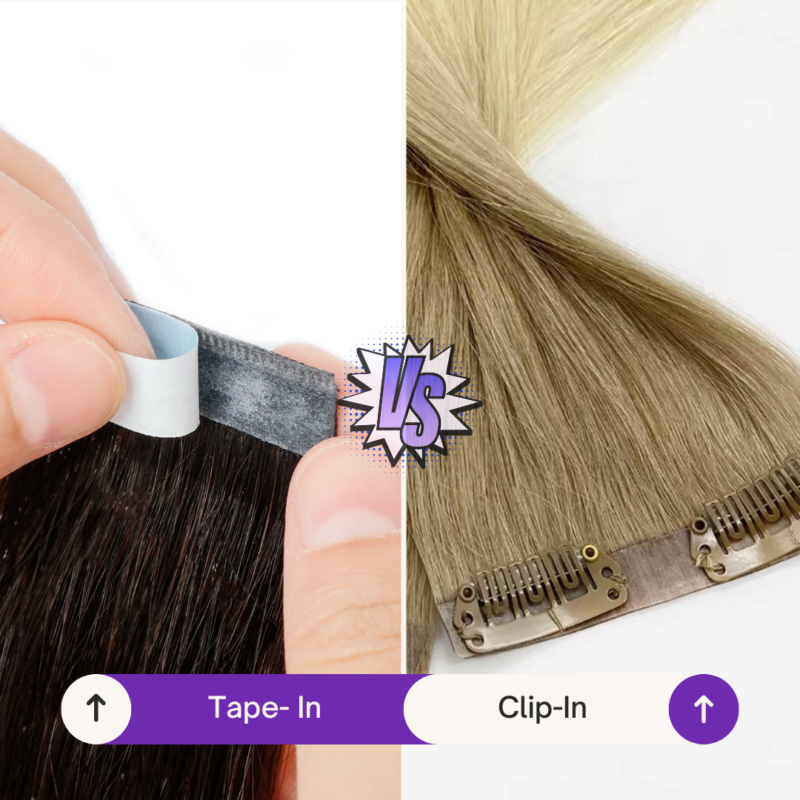Hair blog, Hair extensions
Comparison of Tape-In and Clip-In Hair Extensions: Pros, Cons, and How to Choose
Choosing the right type of hair extensions can dramatically transform your look, but with so many options available, it can be challenging to decide which one is best for you. Tape-in and clip-in hair extensions are two of the most popular types, each with its own set of advantages and disadvantages. This comprehensive guide will help you understand the key differences between tape-in and clip-in extensions, weigh their pros and cons, and provide tips on how to maintain them effectively.
Understanding Tape-In Hair Extensions
Tape-in hair extensions consist of small wefts of hair attached to a strong adhesive tape. These extensions are applied by sandwiching sections of your natural hair between two wefts. This method is known for its quick application and natural look, making it a popular choice among hair extension enthusiasts.
Advantages of Tape-In Hair Extensions:
1. Natural Appearance:
Tape-in extensions lie flat against the scalp, providing a seamless blend with your natural hair. This results in a natural and voluminous look that can be difficult to achieve with other types of extensions.
2. Comfortable Wear:
Due to their lightweight design, tape-in extensions are comfortable to wear, even for extended periods. They do not pull on your natural hair, reducing the risk of discomfort or damage.
3. Long-Lasting:
When properly cared for, tape-in extensions can last for 6 to 8 weeks before needing reapplication. They can also be reused multiple times with the use of new adhesive strips.
4. Versatile Styling:
Tape-in extensions can be styled just like your natural hair. You can curl, straighten, or even dye them (with professional guidance), allowing for a variety of hairstyles.
Disadvantages of Tape-In Hair Extensions:
1. Professional Application Required:
Tape-in extensions typically need to be applied and removed by a professional to ensure they are attached securely and do not damage your natural hair.
2. Maintenance:
These extensions require regular maintenance, including the use of sulfate-free shampoos and conditioners to preserve the adhesive bond.
3. Visibility of Tapes:
If not applied correctly, the adhesive tapes can become visible, particularly if you have fine hair. Ensuring proper application is crucial to avoid this issue.
4. Cost:
The initial cost of tape-in extensions can be higher compared to clip-ins. However, their reusability can offset this cost over time.
Understanding Clip-In Hair Extensions
Clip-in hair extensions consist of hair wefts attached to small clips. These extensions can be easily clipped onto your natural hair, providing instant length and volume. Clip-ins are a popular choice for those looking for a temporary hair enhancement solution.
Advantages of Clip-In Hair Extensions:
1. Easy Application:
Clip-in extensions can be applied at home without professional assistance. They simply clip onto your natural hair, making them a convenient option for quick transformations.
2. Temporary Use:
Clip-ins are ideal for temporary changes. You can easily remove them at the end of the day, making them suitable for special occasions or experimenting with new styles.
3. Cost-Effective:
Clip-in extensions are generally more affordable than tape-ins and do not require professional application, reducing overall costs.
4. Low Maintenance:
Since clip-ins are removed daily, they require less maintenance compared to tape-in extensions. You can wash and store them separately, preserving their quality.
Disadvantages of Clip-In Hair Extensions:
1. Less Natural Look:
While high-quality clip-ins can blend well with natural hair, they may not look as seamless as tape-ins, especially if not applied correctly.
2. Discomfort:
Clip-in extensions can sometimes feel heavy or cause discomfort if worn for extended periods. The clips can also tug on your natural hair, leading to potential damage.
3. Limited Styling Options:
Clip-ins are not recommended for activities like swimming or high-intensity workouts, as the clips may become loose or visible.
4. Durability:
Clip-in extensions may not last as long as tape-ins due to the constant clipping and unclipping process, which can wear out the clips and the hair wefts.
Choosing Between Tape-In and Clip-In Extensions
When deciding between tape-in and clip-in hair extensions, consider the following factors:
1. Purpose:
– If you need a long-term solution and plan to wear extensions daily, tape-ins may be the better choice due to their natural appearance and comfort.
– If you want extensions for occasional use or special events, clip-ins offer a convenient and affordable option.
2. Budget:
– Tape-in extensions have a higher upfront cost but can be reused multiple times, making them cost-effective in the long run.
– Clip-ins are more affordable initially and do not require professional application, reducing overall expenses.
3. Maintenance:
– Tape-ins require more maintenance and regular salon visits for reapplication.
– Clip-ins are low maintenance and can be easily cared for at home.
4. Comfort:
– Tape-ins are lightweight and comfortable for prolonged wear.
– Clip-ins can be uncomfortable if worn for extended periods and may tug on natural hair.
5. Lifestyle:
– Tape-ins are suitable for an active lifestyle, as they remain secure during activities like swimming and exercising.
– Clip-ins are better for temporary use and can be removed before engaging in activities that may cause them to slip.
Tips for Maintaining Hair Extensions
Regardless of the type of extensions you choose, proper maintenance is essential to ensure they look their best and last as long as possible. Here are some tips for maintaining both tape-in and clip-in hair extensions:
1. Use the Right Products:
– Invest in sulfate-free shampoos and conditioners to avoid weakening the adhesive of tape-ins and to keep clip-ins in good condition.
– Use lightweight, non-greasy products to prevent buildup on the extensions.
2. Gentle Brushing:
– Use a brush designed for hair extensions to detangle gently. Start from the tips and work your way up to avoid pulling on the extensions.
– Brush your extensions daily to prevent tangling and matting.
3. Heat Protection:
– When styling with heat tools, use a heat protectant spray to minimize damage to both tape-ins and clip-ins.
– Avoid applying direct heat to the adhesive tapes of tape-ins to prevent weakening the bond.
4. Regular Washing:
– Wash your extensions as needed, but avoid over-washing to prevent drying out the hair. Tape-ins should be washed gently to preserve the adhesive.
– Clip-ins can be washed separately from your natural hair. Follow the manufacturer’s instructions for the best results.
5. Proper Storage:
– Store clip-in extensions in a cool, dry place, preferably in a dedicated storage case to prevent tangling and damage.
– Tape-ins can remain in your hair for several weeks, but ensure they are stored properly when not in use to maintain their quality.
6. Professional Maintenance:
– Schedule regular salon visits for tape-in extensions to ensure they are reapplied correctly and your natural hair remains healthy.
– Seek professional advice for any issues with clip-ins to avoid damaging your natural hair.
Final Thoughts
Both tape-in and clip-in hair extensions offer unique benefits and drawbacks, catering to different needs and lifestyles. Tape-in extensions are ideal for those seeking a long-term, natural-looking solution, while clip-in extensions provide a flexible and cost-effective option for temporary changes. By understanding the pros and cons of each type, you can make an informed decision and enjoy the full potential of your hair extensions.
ADY’s Tape-In and Clip-In are the most requested hair extension methods. They are lightweight, non-damaging, discreet and can be installed in less than an hour. They’re 100% reusable–they can typically be reinstalled up to 3 times making them a great investment!

